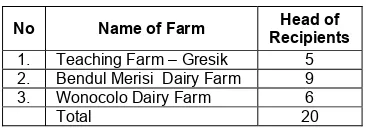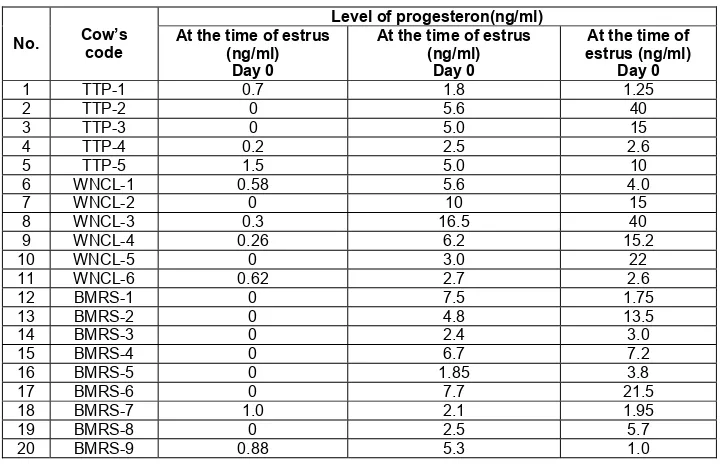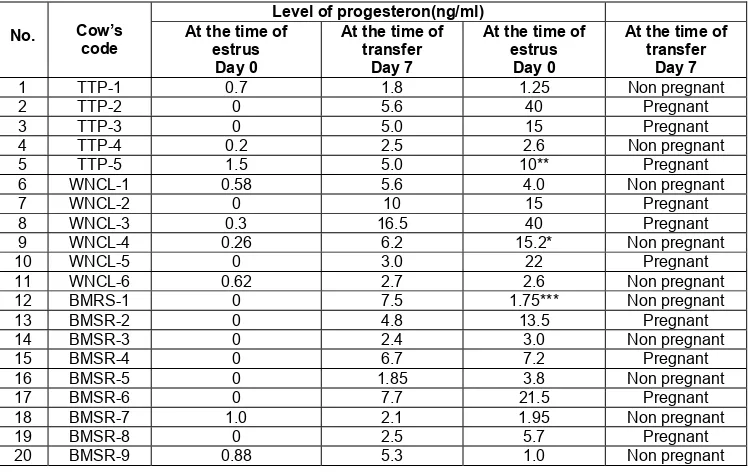THE SUCCESS OF EMBRYO TRANSFER IN DAIRY
CATTLE RECIPIENT USING BEEF CATTLE EMBRYOS
Tita Damayanti Lestari
1*, Ismudiono Ismudiono
1, Trilas Sardjito
1,
Pudji Srianto
11Department of Veterinary Reproduction, Faculty of Veterinary Medicine,
Universitas Airlangga, Indonesia
Abstract
A field research on “The Success of Embryo Transfer in Dairy Cattle Recipient using Beef Cattle Embryos” has been conducted. Prior to the research, selection of dairy cow recipients has been done. It has been selected, from three different farm locations i.e. Bendul Merisi Farm: 9 head; Teaching Farm 5 head and Wonocolo 6 head. The 20 recipients have been estrous synchronized prior to embryos transferred. Blood samples were collected three times i.e.: at onset of estrous, at receiving embryo (day 7) and day 21 after estrous, to measure the concentration of progesterone as the parameters. Further parameters were non return rate and pregnancy rate. Pregnancy detection was done by rectal exploration on day 90 after transferred of embryos. Result shows 11 head (55%) dairy cow recipients get pregnant. They are 3 heads from Teaching Farm (60%), 4 heads (44.44%) from Bendul Merisi Farm and 4 heads (66.66%) from Wonocolo Farm In conclusion, dairy cow recipients can accept embryos derived from beef cattle.
Key words: Embryo Transfer, Beef Cattle Embryo, Dairy Cattle Recipient
INTRODUCTION1
Increasing meat demand especially from beef cattle will lead to an open broadly development of beef cattle business in Indonesia. Transfer embryo technology will then become an important role to fasten beef cattle production to fulfill the demands. Embryo transfer is a program to implant the embryo derived from an exotic breed or excellent production animal to the uterus of recipients. The success of embryo transfer is depending on several conditions i.e.: recipients’ cow, if they are not in good condition, the embryo transfer result will poor; rearing management; culture of farmer, quite frequent after being transferred, the cow has to work as draft animal or working in paddy field.
In Indonesia, mostly beef cattle including beef cow are proposed to work in the field, therefore selection of beef cow recipient is quite difficult [5]. Pregnant beef cow is frequently use as draft animal as well. The objective of this research is to find out whether the embryo of beef cattle is transferable to
*Corresponding author: [email protected]
The manuscript was received: 12.02.2016 Accepted for publication: 01.03.2016
dairy cow instead of transferring to beef cattle as the mother.
Existence of fetus within the uterus is might be a problem. Fetus heritages genetically character from its’ father, and it means as a foreign thing or strange for the mother. If the mother cannot accept the embryo, she can reject it. The success of fertilization is followed by the embryo ability in giving signal to the maternal system or endometrial mother in term of blocking corpus luteum (CL) regression. in order to maintain production of progesterone by its lutein cells [8].
Existence of CL is important to maintain pregnancy in all species. Zygote synthesis or secretes steroid and protein as a sign or signal of its existence to the maternal system. These molecules directs’ synthesis and releases luteolytic Prostaglandin F 2 alpha
(PGF2α) in uterus to avoid CL regression [2].
Maternal recognition of pregnancy in cow is between days 16 -19 of pregnancy [10]. Bovine zygote produces an amount of acid protein with low molecule weight such as: bovine trophoblast protein-1 (bTP-1). This protein is classified within interferon-tau and
named bovine interferon-tau (bIFN-).
Endomerium pregnant cow produces
endometrium prostaglandin synthesis-inhibitor (EPSI) wich is specifically depress PGF 2 alpha synthesis [2]. This inhibitor arises as linoleat acid. Ratio linoleat acid and arachidonate acid (PGF2 alpha precursor) is higher in pregnant cow compare to non pregnant cow. This is lead to the importance to chance lipid composition in endometrium tissue in maternal recognition of pregnancy of cow [9].
Maternal recognition of pregnancy is meant as an interaction between maternal unit and the zygote products of protein. This interaction gives a signal to the mother to maintain the pregnancy [10]. This communication happens in several critical stages during pregnancy, but one important stage of this process in ruminant involved paracrine regulation. Zygote in endometium regulates paracrine to weakened secretion of PGF 2 alpha which has luteolytic character. According to Thatcher (1986) luteolytic effect which is belong to the zygote leads to keep the existence of CL in sheep and cow.
METHOD
This research used twenty head of FH dairy cow. All those cows were implanted by embryos through embryo transfer technique. Frozen beef embryos derived from Simental breed were purchased from BET Cipelang West Java.
All cows were measured the progesterone concentration to define their reproduction activity. Individual observation was also done by rectal palpation to learn its corpus luteum. Prior to transfer of embryo, all cows were estrous synchronized using PGF2α intra vulva. PGF2α was given twice i.e.: 11 days before estrous and three days post administration. And it is interpreted by day 0 of the estrous cycle. All cows were then transferred by embryos on day 6-7 (depends of the embryos age).
Blood samples from the cow were done to measure their progesterone concentration and
were collected three times i.e.: at onset of estrous, at transferring time and 21 days after estrous to observe their progesterone concentration. On day 6 – 7, after onset of estrous, meant day 0, the beef cattle embryos were transferred to dairy cow recipient. At the same time of transferring, cows were injected by hCG (human chorionic gonadothrophin). Estrous has detected on 21 – 24 days after being transferred due to non return rate.
Detection of pregnancy was done by rectal exploration on day 90 to define pregnancy. Parameter of observation were progesterone concentration on day 0, day 7 (transferring time) and day 21 after transfer. Data collected was analyzed descriptively. Pregnancy rate and calves born sex were analyzed by Chi-square.
RESULTS AND DISCUSSIONS
Research was conducted in three dairy farms with the same character. Selected was done to find dairy cows as recipients. Selection was based on the conditions of recipient’s procurements, such as: physically health, history of diseases especially reproduction disorder. Selection was directed to examine their reproductive organs and learn their normal estrous cycle. Result of selection is shown in Table 1.
become pregnant. These results are presented
in Table 2 and the percentage graph is can be seen in Figure 1.
Table 2 Pregnancy rate recognized by rectal palpation on day 90 post transferred in dairy cow recipients
No. Farm Total pregnant recipients (head)
1. Taman Ternak Pendidikan – Gresik 3 (60%)
2. Peternakan Sapi Perah Bendul Merisi 4 (44.44%)
3. Peternakan Sapi Perah Wonocolo 4 (66.66%)
Total 11 (55%)
Figure 1 Pregnancy percentage of dairy cows recipient in three farms
All dairy cows recipients, were measured their progesterone hormone levels using Elisa technique. Examination progesterone levels are taken from the blood serum of cows at the time of estrus, time of transfer and on day
21 post-estrus. Serum progesterone levels of dairy cow recipients can be seen in Table 3 and Graph of progesterone concentration is presented in Figure 2.
Table 3 Blood serum progesterone levels of dairy cows recipients at the time of estrus, time of transfer and on day 21 post-estrus
No. Cow’s code
Level of progesteron(ng/ml) At the time of estrus
(ng/ml) Day 0
At the time of estrus (ng/ml)
Day 0
At the time of estrus (ng/ml)
Day 0
1 TTP-1 0.7 1.8 1.25
2 TTP-2 0 5.6 40
3 TTP-3 0 5.0 15
4 TTP-4 0.2 2.5 2.6
5 TTP-5 1.5 5.0 10
6 WNCL-1 0.58 5.6 4.0
7 WNCL-2 0 10 15
8 WNCL-3 0.3 16.5 40
9 WNCL-4 0.26 6.2 15.2
10 WNCL-5 0 3.0 22
11 WNCL-6 0.62 2.7 2.6
12 BMRS-1 0 7.5 1.75
13 BMRS-2 0 4.8 13.5
14 BMRS-3 0 2.4 3.0
15 BMRS-4 0 6.7 7.2
16 BMRS-5 0 1.85 3.8
17 BMRS-6 0 7.7 21.5
18 BMRS-7 1.0 2.1 1.95
19 BMRS-8 0 2.5 5.7
Figure 2 Graph of blood serum progesterone levels of dairy cows recipients at the time of estrus, time of transfer and on day 21 post-estrus
Dairy cows recipients can receive cattle embryos without any rejection or abortion although they come from different type of cattle. The presence of the fetus and growing in the intrauterus environment can be said to be a serious problem for the female animal as it is recognized as a foreign thing. Fetal genetic characteristics inherited from his father is strange for the mother, so it can be considered a foreign network of other individuals in the same species. If the mother can not receive embryos that are considered foreign, it can be rejected [4]. The atmosphere to the conceptus caused by genes inherited from his father if known as a foreign protein for the mother is a problem to the viviparous species because the immune system from the mother can potentially destroy the concept.
Maternal recognition and pregnancy is
influenced by embryo through secretion of
interferon-tau (IFN-). IFN- is an
antiluteolytic substance to prevent CL lysis, by inhibiting PGF 2 alpha release from uterus. This inhibition is accompanied by decrease of OTR, oxytocin receptor endometrium [1]. Embryo fail to produce an
amount of IFN-, causes an early embryonic
death [7].
Table 4 Progesteron level in blood serum of dairy cow recipients on the time of estrus, relatively high pregnancy rate. These results prove that there is no rejection of the endometrium in dairy cow recipient for the embryo derived from beef cattle. Thus pregnancy can take place.
The successful implementation of embryo transfer depends on three things:
1. Quality of embryos to be transferred; such as age, type of embryo (frozen / fresh), method of freezing and the presence of contamination or infection of the embryo. 2. Skills of the operators in transferring embryos such as capabilities appropriately in deposited embryo in the apex of cornua uterus, and quickly transfer in the correct time, no injuries to the uterus as well as the animals remain calm / not stressed. 3. Response to synchronize recipient cows, feeding the animal with appropriate nutrition, the condition of the animal body with the BCS (Body Condition Score) moderate (2.8 to 3.5), no inflammation of the reproductive organs, ovaries and normal corpus luteum blood serum of dairy cow recipients on day 21 post-transfer show high and were detected as pregnant (by rectal palpation 90 days)
2. Pregnancy rate of recipient dairy cows receiving frozen embryo from beef cattle is good enough 55%
3. There were no signs of rejection (immune response) of dairy cow recipients who received embryos from beef, although there are early embryonic death and abortion in some recipients.
Suggestion:
1. Need to do further research to determine the pregnancy rate which occurred in beef cattle recipient compared to dairy cows’ recipient
REFERENCES
[1]. Flint, A.P.F., 1995: Interferon, the oxytocin
receptor and the maternal recognition of pregnancy in ruminants and non-ruminants: a comparative approach. Reprod. Fert.Dev. 7: 313
[2]. Geisert, R.D., J.R. Malayer, 2000: Implantation, dalam Hafez, E.S.E and B. Hafez.
2000. Reproduction in Farm Animals. 7ed..
Lippincott Williams & Wilkins. Philadelphia. [3]. Gross, T.S., W.W. Thatcher, P.J. Hansen, J.W. Johnson, S.D. Helmer, 1988: Presence of an Intracellular Endometrial Inhibit of Prostaglandin Synthesis During Early Pregnancy in the Cow. Prostaglandins 1988; 35: 359 – 378.
[4]. Hafez, E.S.E, B. Hafez, 2000: Fertilization and Cleavage dalam Hafez, E.S.E and B. Hafez.
Reproduction in Farm Animals. 7ed.. Lippincott
Williams & Wilkins. Philadelphia
[5]. Ismudiono I., Hardjopranjoto S., Mahaputra L., Hariadi M. dan Srianto P., 1992: Transfer Embrio dengan menggunakan Embrio Beku pada
Sapi Perah. Lembaga Penelitian Universitas Airlangga. Surabaya
[6]. Ismudiono I, Mahaputra L., Hariadi M. dan Srianto P., 1996: Transfer Embrio Sapi Perah dengan Menggunakan Embrio Sapi Potong sebagai Resipien. Penelitian DP3M. Lembaga Penelitian Universitas Airlangga. Surabaya.
[7]. Kerbler, T.L., M.M. Buhr, L.T. Jordan, K.E. Leslie, J.S. Alton, 1997: Relationship between Maternal Plasma Progesterone Concentration and Interferon-tau Synthesis by the Conceptus in Cattle. Theriogenology. 47:703
[8]. Lestari T.D. dan Ismudiono I., 2013: Ilmu Reproduksi Ternak. Airlangga University Press. Surabaya.
[9]. Staples, C.R., J.M. Burke, W.W. Thatcher, 1998: Influence of supplemental fats on reproductive tissues and performance of lactating cows. J. Dairy Sci. 81: 856–871.



